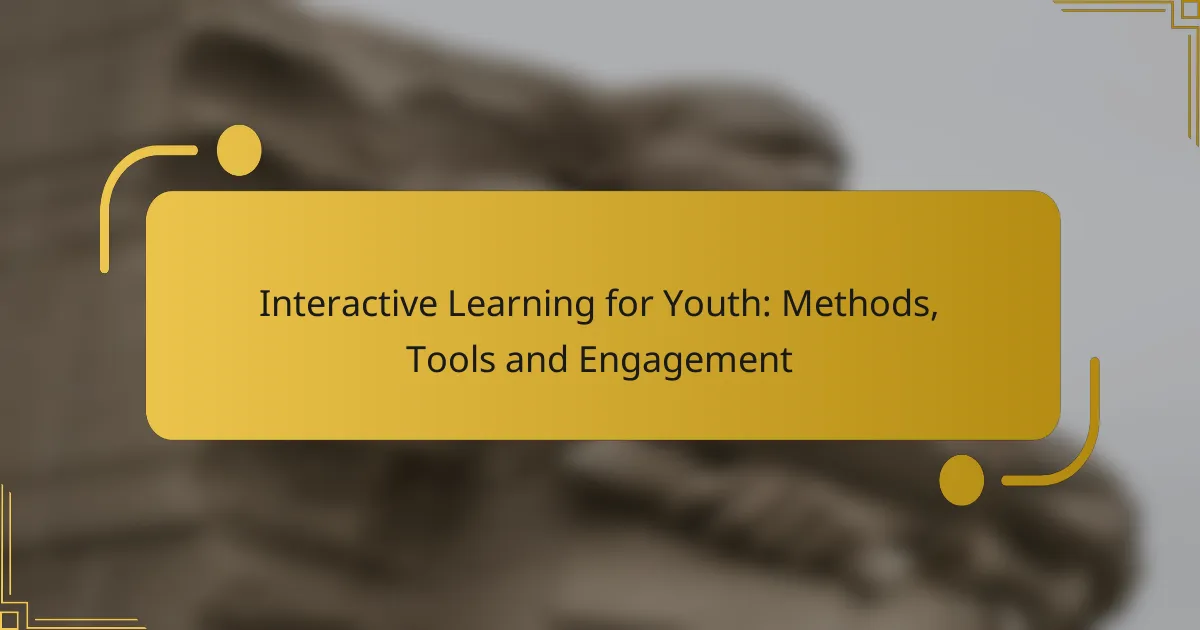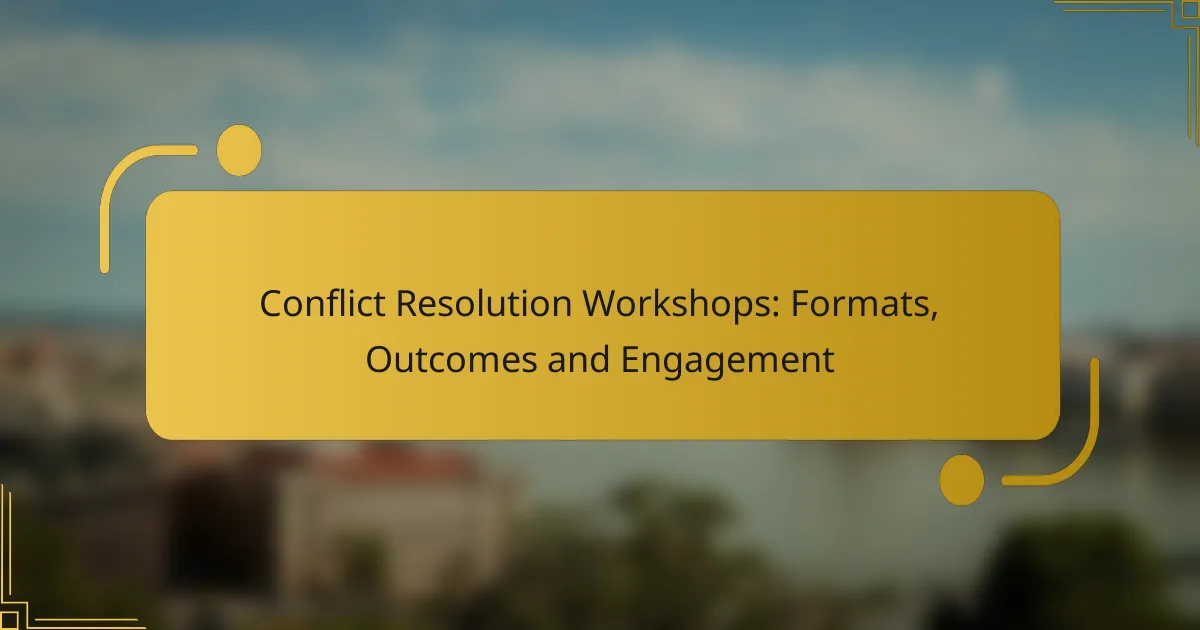Interactive learning for youth emphasizes active engagement, critical thinking, and collaboration, transforming traditional educational experiences. By integrating technology and practical activities, educators can create immersive environments that enhance understanding and retention. Effective engagement strategies focus on relevance and relatability, ensuring that learning is enjoyable and connected to students’ interests.
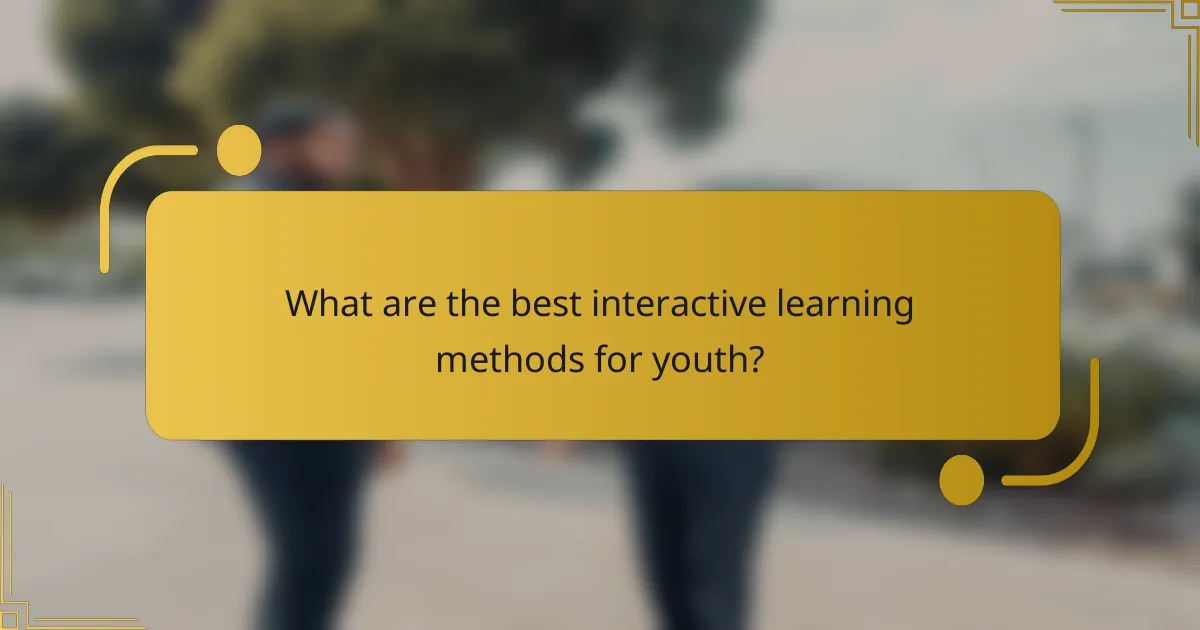
What are the best interactive learning methods for youth?
The best interactive learning methods for youth include approaches that actively engage students in the learning process, fostering critical thinking and collaboration. These methods often combine practical activities with technology to create a dynamic educational experience.
Project-based learning
Project-based learning (PBL) involves students working on a project over an extended period, which allows them to explore real-world problems and challenges. This method encourages critical thinking, creativity, and collaboration as students must plan, research, and present their findings.
To implement PBL, educators should define clear objectives, provide resources, and facilitate group work. For example, a project could involve students designing a sustainable garden, requiring them to research plants, budgeting, and environmental impact.
Gamification techniques
Gamification techniques incorporate game elements into educational activities to enhance engagement and motivation. By using points, badges, and leaderboards, educators can create a competitive yet fun learning environment that encourages participation.
For effective gamification, consider using educational apps or platforms that allow for tracking progress and rewarding achievements. Simple classroom games, like quizzes with prizes, can also motivate students to learn while enjoying the process.
Collaborative learning
Collaborative learning emphasizes teamwork and peer interaction, allowing students to learn from each other. This method fosters communication skills and helps students develop a deeper understanding of the material through discussion and shared experiences.
To facilitate collaborative learning, educators can organize group projects or study sessions. For instance, students could work in pairs to solve math problems, promoting discussion and peer support while reinforcing their understanding of the concepts.
Flipped classroom model
The flipped classroom model reverses traditional teaching by having students learn new content at home and engage in hands-on activities in class. This approach allows for more personalized instruction and active participation during classroom time.
To implement this model, educators can assign video lectures or readings for homework and use class time for discussions, group work, or problem-solving activities. This method can be particularly effective in subjects like science or mathematics, where practical application is crucial.
Experiential learning
Experiential learning focuses on learning through experience, allowing students to apply knowledge in real-world contexts. This method enhances retention and understanding by involving students in hands-on activities that relate to their lives.
Examples of experiential learning include internships, field trips, or service-learning projects. Educators should ensure that these experiences are relevant and provide opportunities for reflection to maximize the learning outcomes.
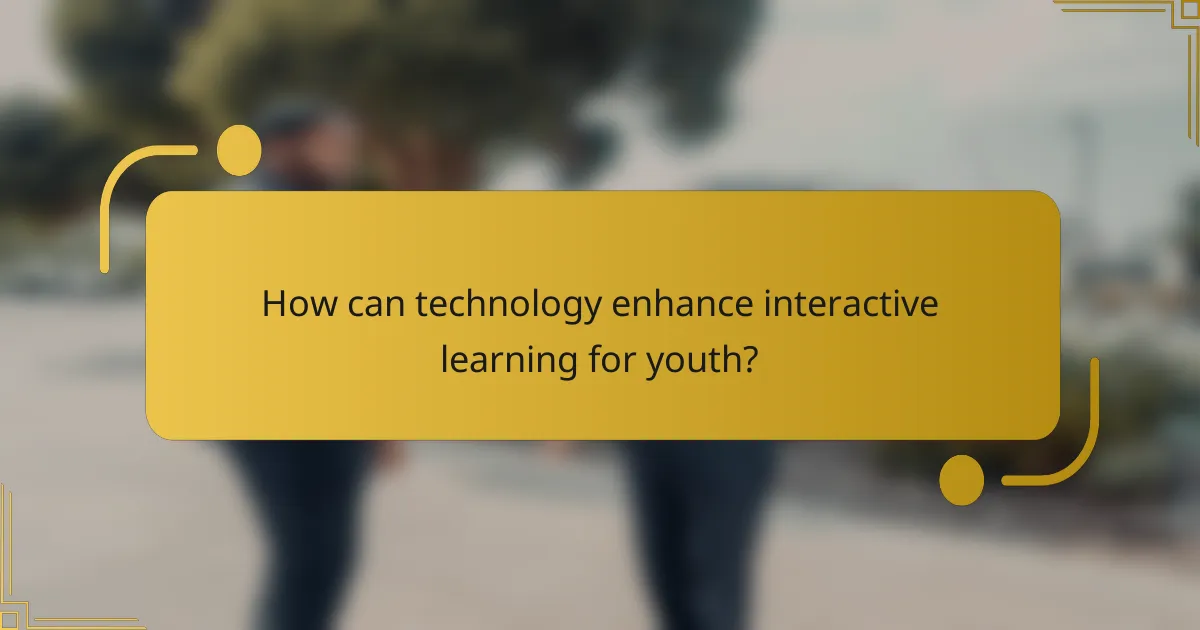
How can technology enhance interactive learning for youth?
Technology can significantly enhance interactive learning for youth by providing immersive experiences, personalized learning paths, and collaborative opportunities. These tools engage students more effectively than traditional methods, fostering deeper understanding and retention of knowledge.
Virtual reality applications
Virtual reality (VR) applications create immersive environments where youth can explore subjects in a hands-on manner. For instance, students can take virtual field trips to historical sites or conduct science experiments in a simulated lab. This engagement can lead to increased motivation and a better grasp of complex concepts.
When implementing VR in educational settings, consider the hardware requirements and ensure that the content aligns with curriculum standards. Schools may need to invest in VR headsets and software, which can vary in cost from a few hundred to several thousand dollars depending on the scale of the deployment.
Interactive educational platforms
Interactive educational platforms offer dynamic content that adapts to the learner’s pace and style. These platforms often include quizzes, games, and multimedia resources that make learning more engaging. Popular examples include platforms like Kahoot! and Quizlet, which allow for real-time feedback and competition among peers.
When choosing an interactive platform, look for features such as user-friendly interfaces, compatibility with various devices, and comprehensive analytics to track progress. Many platforms offer free versions, but premium subscriptions may provide additional resources and functionalities.
Mobile learning apps
Mobile learning apps enable youth to access educational content anytime and anywhere, making learning more flexible. Apps like Duolingo for language learning or Khan Academy for various subjects allow students to learn at their own pace. This accessibility is particularly beneficial for students who may need extra practice outside of school hours.
When selecting mobile apps, consider their educational value, user reviews, and whether they offer offline capabilities. Many apps are free, but some may include in-app purchases or subscription models that provide enhanced features.
Online collaborative tools
Online collaborative tools facilitate teamwork and communication among students, promoting a sense of community in learning. Tools like Google Workspace and Microsoft Teams allow students to work together on projects, share resources, and provide peer feedback in real-time.
To maximize the effectiveness of these tools, establish clear guidelines for collaboration and encourage regular check-ins. Be mindful of privacy settings and ensure that students understand how to use these platforms safely and responsibly. Many of these tools are free for educational use, but premium features may require a subscription.
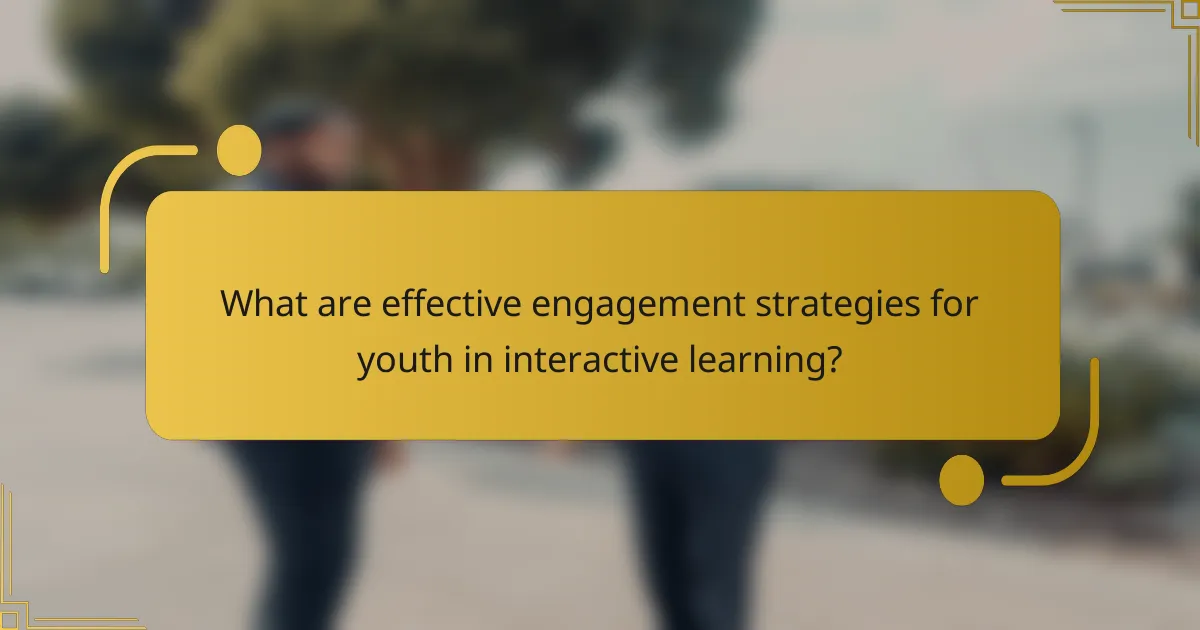
What are effective engagement strategies for youth in interactive learning?
Effective engagement strategies for youth in interactive learning focus on making the learning experience relevant, relatable, and enjoyable. By incorporating students’ interests, utilizing social media, and providing real-world connections, educators can foster a more dynamic and participatory learning environment.
Incorporating student interests
Incorporating student interests into interactive learning can significantly enhance engagement. When lessons align with what students are passionate about, they are more likely to participate actively and retain information. For example, using popular culture references or current events that resonate with students can make lessons more relatable.
To implement this strategy, educators can conduct surveys to identify student interests or allow students to choose project topics that excite them. This approach not only boosts motivation but also encourages creativity and critical thinking.
Utilizing social media for learning
Utilizing social media as a learning tool can create a familiar and interactive platform for youth. Platforms like Instagram, Twitter, and TikTok can be used to share educational content, facilitate discussions, and promote collaborative projects. This method leverages the technology that students are already comfortable with, making learning more accessible.
Educators should establish clear guidelines for social media use to ensure a safe and productive environment. For instance, creating dedicated groups or hashtags can help streamline communication and keep discussions focused on educational topics.
Providing real-world connections
Providing real-world connections in interactive learning helps students see the relevance of their education. By linking lessons to real-life scenarios, students can better understand the practical applications of their knowledge. This can be achieved through field trips, guest speakers, or project-based learning that addresses community issues.
To enhance this strategy, educators can collaborate with local businesses or organizations for internships or service-learning opportunities. Such experiences not only enrich learning but also help students develop valuable skills and networks for their future careers.
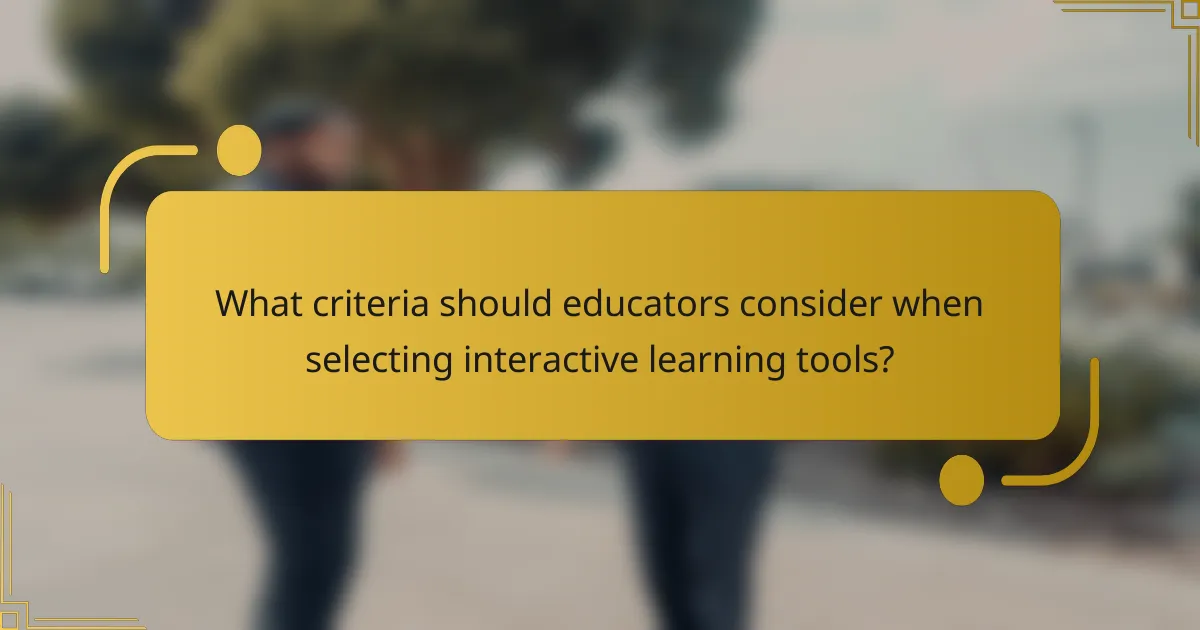
What criteria should educators consider when selecting interactive learning tools?
Educators should prioritize user-friendliness, alignment with learning objectives, and accessibility features when selecting interactive learning tools. These criteria ensure that the tools enhance the educational experience and cater to diverse student needs.
User-friendliness
User-friendliness is crucial for ensuring that both educators and students can navigate interactive learning tools with ease. Tools should have intuitive interfaces that minimize the learning curve and allow users to focus on content rather than technology.
When evaluating user-friendliness, consider conducting trials with a small group of students to gather feedback. Look for tools that provide clear instructions and support, such as tutorials or help centers, to assist users in overcoming any challenges.
Alignment with learning objectives
Interactive learning tools must align with the specific learning objectives of the curriculum to be effective. This means that the features and content of the tools should support the desired outcomes of lessons and assessments.
To ensure alignment, educators should map the functionalities of the tools to their lesson plans. For example, if the goal is to enhance critical thinking, choose tools that promote problem-solving and collaboration among students.
Accessibility features
Accessibility features are essential for creating an inclusive learning environment. Tools should accommodate various learning styles and needs, including support for students with disabilities.
When assessing accessibility, look for features such as text-to-speech, closed captioning, and customizable display options. Additionally, ensure that the tools comply with established accessibility standards, such as the Web Content Accessibility Guidelines (WCAG), to provide equitable access for all learners.

What are the benefits of interactive learning for youth?
Interactive learning offers numerous benefits for youth, including increased engagement and better understanding of material. By actively participating in their education, young learners can develop essential skills that enhance their academic performance and personal growth.
Improved retention rates
Interactive learning significantly boosts retention rates among youth by encouraging active participation. When students engage with the material through discussions, hands-on activities, or technology, they are more likely to remember what they have learned.
For example, studies suggest that retention can improve by 50% or more when students participate in interactive activities compared to traditional lecture-based learning. Techniques such as group projects, quizzes, and educational games can be effective in reinforcing knowledge.
Enhanced critical thinking skills
Interactive learning fosters critical thinking skills by challenging students to analyze, evaluate, and create rather than simply memorize information. This approach encourages youth to ask questions, solve problems, and think independently.
Activities like debates, case studies, and simulations allow students to explore different perspectives and develop their reasoning abilities. Implementing these methods can lead to a more profound understanding of complex topics and prepare students for real-world challenges.
